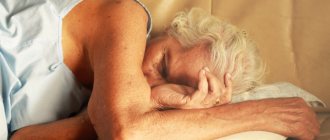For stupor as a disturbance of consciousness or “precoma,” see stupor.
| Stupor | |
| Catatonic stupor | |
| ICD-11 | 6A20.Z6A20.Z (catatonic) |
| ICD-10 | 20.220.2 (catatonic), 31.—ЗЗ. (depressive), 44.244.2 (dissociative), 30.230.2 (manic) |
| ICD-9 | 295.2295.2 (catatonic), 298.8298.8 (psychogenic) |
| ICD-9-CM | 295.2295.2 (catatonic), 296.7296.7 (circular), 296.89296.89 (manic), 298.8298.8 (psychogenic) |
| MeSH | D053608 |
Stupor
(from Latin stupor “numbness, stupor”) - in psychiatry, one of the types of movement disorder, which is complete immobility with mutism and weakened reactions to irritation, including pain. In English-language literature, stupor (English stupor) also refers to deep depression of consciousness, almost similar to stupor[1].
There are various types of stuporous states:
- catatonic,
- reactive,
- depressive,
- manic stupor.
Catatonic stupor
occurs most often [
source not specified 1825 days
], it develops as a manifestation of the catatonic syndrome and is characterized by passive negativism or waxy flexibility or (in the most severe form) severe muscle hypertension with numbness of the patient in a position with bent limbs.
Being in a stupor, patients do not come into contact with others, do not react to current events, various inconveniences, noise, wet and dirty bed. They may not move if there is a fire, earthquake or some other extreme event. Patients usually lie in one position, the muscles are tense, the tension often begins with the masticatory muscles, then goes down to the neck, and later spreads to the back, arms and legs. In this state, there is no emotional or pupillary response to pain. Bumke's sign—dilation of the pupils in response to pain—is absent.
In stupor with waxy flexibility
In addition to mutism and immobility, the patient maintains the given position for a long time, freezes with a raised leg or arm in an uncomfortable position. Pavlov's symptom is often observed: the patient does not respond to questions asked in a normal voice, but responds to whispered speech. At night, such patients can get up, walk, put themselves in order, sometimes eat and answer questions.
Negativistic stupor
characterized by the fact that with complete immobility and mutism, any attempt to change the patient’s position, lift him or turn him over causes resistance or opposition. It is difficult to get such a patient out of bed, but once raised, it is impossible to put him back down. When trying to be brought into the office, the patient resists and does not sit down on the chair, but the seated person does not get up and actively resists. Sometimes active negativism is added to passive negativism. If the doctor extends his hand, he hides his hand behind his back, grabs food when it is about to be taken away, closes his eyes when asked to open, turns away from the doctor when asking him a question, turns and tries to speak when the doctor leaves, etc.
Stupor with muscle numbness
characterized by the fact that patients lie in the intrauterine position, muscles are tense, eyes are closed, lips are extended forward (proboscis symptom). Patients usually refuse to eat and have to be fed through a tube or undergo amytalcaffeine disinhibition and feed at a time when the manifestations of muscle numbness decrease or disappear.
For depressive stupor
with almost complete immobility, patients are characterized by a depressed, pained expression on their face. You manage to make contact with them and get a monosyllabic answer. Patients in a depressive stupor are rarely untidy in bed. Such a stupor can suddenly give way to an acute state of excitement - melancholic raptus, in which patients jump up and injure themselves, can tear their mouths, tear out an eye, break their heads, tear their underwear, and can roll on the floor howling. Depressive stupor is observed in severe endogenous depression.
In apathetic stupor
patients usually lie on their backs, do not react to what is happening, and muscle tone is reduced. Questions are answered in monosyllables with a long delay. When contacting relatives, the reaction is adequate emotional. Sleep and appetite are disturbed. They are untidy in bed. Apathetic stupor is observed with prolonged symptomatic psychoses, with Gaye-Wernicke encephalopathy
Dissociative stupor
, also known as
hysterical stupor
, occurs in dissociative disorders and is characterized by a lack of physical conditioning. Characterized by immobility with an expressive posture, narrowing of consciousness and preservation of affective reactions to significant impressions[2]. The latter can be expressed in facial expressions of suffering and tears[2]. In ICD-10, this type of stupor is classified under F44.2.
Stupor
Stupor
(from Latin stupor “numbness, stupor”) - in psychiatry, one of the types of movement disorder, which is complete immobility with mutism and weakened reactions to irritation, including pain. There are various types of stuporous states: catatonic, reactive, depressive stupor. Catatonic stupor is the most common; it develops as a manifestation of the catatonic syndrome and is characterized by passive negativism or waxy flexibility or (in the most severe form) severe muscle hypertension with numbness of the patient in a pose with bent limbs.
Being in a stupor, patients do not come into contact with others, do not react to current events, various inconveniences, noise, wet and dirty bed. They may not move if there is a fire, earthquake or some other extreme event. Patients usually lie in one position, the muscles are tense, the tension often begins with the masticatory muscles, then goes down to the neck, and later spreads to the back, arms and legs. In this state, there is no emotional or pupillary response to pain. Bumke's syndrome—dilation of the pupils in response to pain—is absent.
Where does the bus go?
A mockingly simple task that appears in all collections of this kind of puzzles - understandable to children and incomprehensible to adults. Where does the bus go?
Solution: Usually adults, seeing a schematic image, instantly forget about the details. In the USA, children often go to school by bus, so they know which side the door is on and how it arrives. They realize that there are not enough doors in the picture. This means the bus is going to the left. Of course, the option that he gives back is not considered.
Causes of stupor
Women are much more likely than men to fall into emotional stupor. This condition usually occurs due to intense mental shocks (fear, horror, grief, disappointment). In this case, motor activity and affective activity are blocked, and mental activity also slows down. This condition can go away without treatment and without any special consequences, or it can lead to a panic state, during which the sick person will rush to perform chaotic actions (run, scream). The consequence of this may be depression. A state of stupor of this type can appear in a woman who has witnessed a catastrophe, an accident, or someone else's suffering. It can occur in soldiers during combat, and also in children, for example, during exams.
Other mathematics
A well-known problem that preschoolers solve in 5-10 minutes. Some programmers take up to an hour to complete it, and many people, after writing several sheets of paper, give up.
Solution: Young children can't write equations or look for mathematical patterns, so they notice that the value depends on the number of circles in each number. There is one circle in 9, two in 8, none in 1, which means 2581 = 2.
This problem has a good analogue:
1 = 5
2 = 25
3 = 125
4 = 625
5 = ?
Types of stupor
Stupor with waxy flexibility
In case of stupor with waxy flexibility, in addition to mutism and immobility, the patient maintains the given position for a long time, freezes with a raised leg or arm in an uncomfortable position. Pavlov's symptom is often observed: the patient does not respond to questions asked in a normal voice, but responds to whispered speech. At night, such patients can get up, walk, put themselves in order, sometimes eat and answer questions.
Negativistic stupor
Negativistic stupor is characterized by the fact that with complete immobility and mutism, any attempt to change the patient’s position, lift him or move him causes resistance or opposition. It is difficult to get such a patient out of bed, but once raised, it is impossible to put him back down. When trying to be brought into the office, the patient resists and does not sit down on the chair, but the seated person does not get up and actively resists. Sometimes active negativism is added to passive negativism. If the doctor extends his hand, he hides his hand behind his back, grabs food when it is about to be taken away, closes his eyes when asked to open, turns away from the doctor when asking him a question, turns and tries to speak when the doctor leaves, etc.
Stupor with muscle numbness
Stupor with muscle numbness is characterized by the fact that patients lie in the intrauterine position, muscles are tense, eyes are closed, lips are pulled forward (proboscis symptom). Patients usually refuse to eat and have to be fed through a tube or undergo amytalcaffeine disinhibition and feed at a time when the manifestations of muscle numbness decrease or disappear.
Depressive stupor
With depressive stupor with almost complete immobility, patients are characterized by a depressed, pained expression on their face. It is possible to make contact with them. get a one-word answer. Patients in a depressive stupor are rarely untidy in bed. Such a stupor can suddenly give way to an acute state of excitement - melancholic raptus, in which patients jump up and injure themselves, can tear their mouths, tear out an eye, break their heads, tear their underwear, and can roll on the floor howling. Depressive stupor is observed in severe endogenous depression.
Apathetic stupor
With apathetic stupor, patients usually lie on their backs, do not react to what is happening, and muscle tone is reduced. Questions are answered in monosyllables with a long delay. When contacting relatives, the reaction is adequate emotional. Sleep and appetite are disturbed. They are untidy in bed. Apathetic stupor is observed with prolonged symptomatic psychoses, with Gaye-Wernicke encephalopathy.
Catatonic stupor
Catatonic stupor is understood as freezing in fear, fright and helplessness during the severe suffering of the Self - consciousness in its various dimensions. Anyone who does not know whether he is still alive, whether he is able to act, is not sure of the unity and separation of his personality from the environment, is capable of freezing in a stupor. Therefore, everything that leads to the restoration of the authenticity of the self-experience can be of therapeutic value for catatonic stupor. So, if the I-identity is lost, sometimes calling by name is enough to improve the patient’s condition. Another patient can be helped to regain the feeling of his activity by doing physical exercises, breathing exercises, etc. with him.
It is clear that in severe cases a purely verbal therapeutic approach is often insufficient. But purely neuroleptic therapy or ECT is not sufficient; the patient must be perceived as an individual. Some patients can only be brought out of their stupor with great difficulty. But even if they are not objectively responding, it is still useful not to leave them alone in this state, but to stay and talk to them. Sometimes it is possible to take a couple of steps with them - and this is the first therapeutic success on the road to a generally meaningful world. Other types of catatonic stupor occur when loaded with hallucinatory and delusional experiences, for example, in ecstasy.
Medical encyclopedia - stuporous conditions
(lat. stupor numbness, immobility; synonym stupor)
psychopathological disorders manifested by immobility, mutism (lack of verbal communication with others), a decrease in all types of sensitivity as a result of suppression of mental activity. Occurs in various mental illnesses.
Patients in S. sit for hours, lie or stand without changing posture. Questions are not answered at all or answered slowly, usually after a pause, with interjections, individual words, and occasionally in short phrases. They, as a rule, do not react to what is happening around them, do not ask for anything, do not eat on their own, do not take care of their appearance, and often resist any attempt to influence them, for example, when feeding, washing, dressing, or performing medical procedures ( negativism). Patients may lack desires and urges to engage in activities (abulia). A condition in which patients experience incomplete immobility with sharply reduced speech activity is defined as substupor.
S. s. accompanied by delusions, hallucinations (Hallucinations), altered affect, confusion. Less commonly, with S., only motor and speech disturbances are noted (the so-called empty stupor). Stupor that occurs with confusion of consciousness in a patient with oneiroid (see Oneiroid syndrome) is called receptor; stupor that occurs against the background of clear consciousness is lucid or effector. Usually the terms “effector stupor” and “lucid stupor” are used to characterize catatonic stupor (see Catatonic syndrome), but they can also be used to characterize other S. s. In patients in S. s. There may be a temporary sharp impoverishment of mental activity, due to which they resemble patients with dementia. S. s. accompanied by somatic disorders, primarily vegetative. Patients' recollection of what happened to them during the period of stupor is often scanty, fragmentary, or completely absent.
Depending on the psychopathological manifestations or nosological affiliation of the mental illness in which S. s. occurs, the following forms of stupor are distinguished: catatonic, psychogenic (see Reactive psychoses), depressive (melancholic), hallucinatory, apathetic (asthenic stupor, or waking coma) , manic, alcoholic, epileptic. Catatonic and psychogenic stupors are more common, followed by depressive and hallucinatory stupors.
With depressive stupor, the patient’s appearance reflects a depressive affect: a hunched posture, the head and gaze are lowered, there are upward horizontal wrinkles on the forehead, the muscles of the lower part of the face are relaxed, the eyes are dry and inflamed. Patients usually respond to calls with individual words spoken in a whisper, or react with simple movements (for example, tilting the head). Depressive stupor lasts several hours or weeks and occurs in manic-depressive psychosis, schizophrenia, and presenile psychoses.
Hallucinatory stupor is usually accompanied by various facial reactions expressing fear, melancholy, detachment, and curiosity. It lasts several minutes or hours. Occurs in senile, intoxication psychoses.
With apathetic stupor, patients usually lie on their backs in a state of prostration and complete muscle relaxation. The expression on his face is devastated, his eyes are wide open; they are indifferent and indifferent to their surroundings; severe cachexia is observed. Apathetic stupor lasts 1-4 months; it occurs in prolonged symptomatic psychoses. In milder cases, when there is only a combination of spontaneity with indifference to the environment, they speak of apathetic syndrome.
With manic stupor, patients, remaining motionless, are able to follow their interlocutor with their eyes, smile, laugh silently; questions are not answered. Occurs in schizophrenia, manic-depressive psychosis.
With alcoholic stupor, patients look drowsy or detached and answer simple questions in monosyllables. Facial expressions are monotonous; an expression of fear, surprise, or concern may appear. They passively submit to inspection. Alcoholic stupor is observed rarely, mainly in alcoholic oneiroid (see Alcoholic psychoses).
With epileptic stupor, the patient's face is motionless with a dull and meaningless expression or a facial reaction of despair, fear, bewilderment. Epileptic stupor is characterized by a sudden change in motor retardation by violent excitement with destructive actions.
Therapeutic pathomorphosis of psychoses and successful treatment of somatic diseases in which S. s. (for example, tuberculosis, malaria, B12-deficiency anemia), led to a weakening of the severity of almost all S. s. This is most clearly observed in catatonic, depressive and apathetic stupor.
The diagnosis is based on the clinical picture and medical history. The differential diagnosis is made with akinesia - a conscious slowdown or cessation of movements during severe pain and psychopathic reactions (see Psychopathy).
Patients in S. s. need immediate placement in a psychiatric hospital; treatment of the underlying disease and concomitant somatic disorders is carried out. They require 24-hour supervision and appropriate care (see Mentally Ill). The prognosis for life is most unfavorable with apathetic stupor. The prognosis for recovery depends on the underlying disease.
Bibliography: Morozov G.V. Stuporous states , M., 1968; bibliography; Guide to Psychiatry, ed. G.V. Morozova, vol. 1, p. 139, M., 1988; Guide to Psychiatry, ed. A. In Snezhnevsky, vol. 1, p. 45, 67, vol. 2, p. 234, 368, M., 1983.
1. Small medical encyclopedia. — M.: Medical encyclopedia. 1991–96 2. First aid. - M.: Great Russian Encyclopedia. 1994 3. Encyclopedic Dictionary of Medical Terms. - M.: Soviet Encyclopedia. - 1982-1984
How to get out of a stupor
Only specialists—psychotherapists, psychologists, psychiatrists—know exactly how to overcome stupor. But if you see that a person close to you is in this state how to get out of the stupor, he definitely needs help, here are a few ways:
- Massaging special points that are located above the pupils of the eyes, exactly in the middle, equidistant from the eyebrows and the beginning of the hairline, can help; these points need to be massaged with the pads of the fingers, index and thumb;
- you can try to evoke any strong emotions in the patient, even negative ones - tell him something in a clear and confident voice, sometimes even a slap in the face helps;
- stupor can go away if you bend the person’s fingers and press them forcefully against the palms, the thumbs should remain straight.
Hannah and the dramatically increased difficulty
A famous meme problem in which the final question seems much more difficult than the condition.
There are n sweets in the bag. Six of them are orange. The rest are yellow. Hannah takes the candy from her bag and eats it. Then he takes another one and eats it again. The probability that she ate two orange candies is 1/3. Prove that n²–n–90=0.
The strange ending to Hannah's story has given rise to many jokes online. Most famous: “Hannah ate some candy. Calculate the circumference of Jupiter's equator using tracing paper and a rusty spoon."
Solution: Many netizens are unable to find a solution because they are convinced that it requires calculating n first, but in reality this is not required.
The probability that Hannah drew an orange candy the first time is 6/n (there are six orange out of n candies in the bag). If Hannah drew an orange candy the first time, then the probability of drawing the same one the second time is 5/(n-1). The probability of drawing two orange candies is the product of these two probabilities.
We get: (6/n)⋅(5/(n-1))=¹⁄₃. Then it is enough to simplify the equation.
Emergency care for stupor
Emergency care for stupor comes down to preventing dangerous actions and ensuring the safety of the patient. With catatonic stupor, this is a readiness to stop sudden impulsive excitement. In case of depressive stupor - preventing the possibility of sudden development of depressive agitation with a desire for suicide, as well as eliminating refusal to eat. It should be borne in mind that psychogenic stupor can be replaced by psychogenic agitation. Emergency care for catatonic stupor in out-of-hospital conditions does not make sense, since attempts to disinhibit the patient can cause agitation and thereby create additional difficulties.
Treatment for stupor
In a hospital setting, thanks to barbamyl-caffeine disinhibition, it is possible to identify the characteristics of the patient’s experiences and thereby determine the nature of the stupor. It also serves as a method of treatment and helps with persistent refusal to eat. At the beginning, 1-2 ml of a 20% caffeine solution is administered, and after 3-5 minutes, 5-10 ml of a 510% barbamyl solution is administered slowly intravenously, monitoring the patient’s condition, and at the first signs of disinhibition, the infusion is stopped so as not to exceed the individual disinhibition dose for this patient and do not induce normal sleep. The administration of barbamyl is stopped at the moment when the patient opens his eyes or when facial, motor or vegetative reactions (in the form of paleness or redness of the face, sweating, etc.) begin to appear; in this case, it is necessary to stimulate the patient’s disinhibition in every possible way: contact him with questions, slow him down, lightly pat on the cheek, etc.
In a psychiatric hospital, catatonic stupor is treated with intramuscular administration of frenolone at a dose of 5-15 mg/day; for lucid stupor, mazeptil is prescribed orally up to 60 mg/day; Barbamilcaffeine disinhibition is also effective. The psychostimulant sydnocarb up to 30-50 mg/day orally is also effective. For stupor with delusions and hallucinations, stelazine (triftazine), haloperidol, and trisedal are used according to the same principles as the treatment of delusional and hallucinatory states.
For depressive stupor, barbamyl-caffeine disinhibition is carried out, melipramine is used up to 200-300 mg/day orally or intramuscularly. For psychogenic stupor, use diazepam (Seduxen, Relanium) up to 30 mg/day orally, preferably intramuscularly; elennium up to 50 mg/day orally, preferably intramuscularly; phenazepam - 3-5 mg/day orally. Stupor in severe somatic diseases requires intensive treatment of the underlying disease. Hospitalization is necessary in a psychiatric hospital for all types of stupor, except for somatogenic stupor, the treatment of which is carried out in the same department where the patient is diagnosed with a somatic disease.










